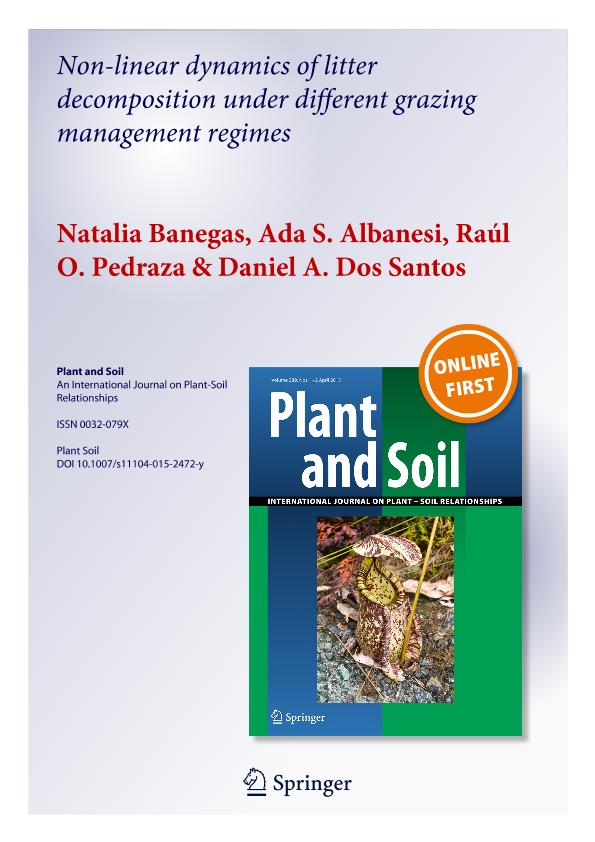Artículo
Non-linear dynamics of litter decomposition under different grazing management regimes
Banegas, Natalia Romina ; Albanesi de Garay, Ada Susana; Pedraza, Raúl Osvaldo; Dos Santos, Daniel Andrés
; Albanesi de Garay, Ada Susana; Pedraza, Raúl Osvaldo; Dos Santos, Daniel Andrés
 ; Albanesi de Garay, Ada Susana; Pedraza, Raúl Osvaldo; Dos Santos, Daniel Andrés
; Albanesi de Garay, Ada Susana; Pedraza, Raúl Osvaldo; Dos Santos, Daniel Andrés
Fecha de publicación:
08/2015
Editorial:
Springer
Revista:
Plant and Soil
ISSN:
0032-079X
Idioma:
Inglés
Tipo de recurso:
Artículo publicado
Clasificación temática:
Resumen
Aims: To understand and model the dynamics of litter decomposition in a climatically seasonal region subject to different modalities of land pasture management. Methods: Decomposition was quantified through the litterbag technique. Sampling was performed at monthly intervals on an annual basis with replications for 2008, 2009 and 2010. Treatments were native vegetation (NV) and grazed (G), grazed and N-fertilized (GF), hayed (H), hayed and N-fertilized (HF) plots. For each combination of treatment and year, a sigmoid model was fitted. Parameters included remnant litter, steepness and inflection of decomposition curve. Results: The sigmoid model adjusted excellently well the data. In considering the overall effect on litter decomposition, treatments differ among them as follows symbolically: ((GF > G) > (HF > H)) > > NV. Results are consistent across the yearly replications. Conclusion: Pasture management (grazed versus hayed) is the primary factor controlling the rate of decomposition, whereas fertilization has a secondary role. The sigmoid model captures realistically the different phases of decomposition detected over a year, namely stationary at conditions of low temperature (later autumn and winter), accelerated at increasing temperature and humidity (transition from spring to summer) and decelerated when residual organic matter becomes less profitable and weather conditions more stringent (summer and earlier autumn).
Palabras clave:
CATTLE
,
CHACO
,
CHLORIS GAYANA
,
GRAZING
,
NITROGEN
,
SIGMOID MODEL
Archivos asociados
Licencia
Identificadores
Colecciones
Articulos(CCT - NOA SUR)
Articulos de CTRO.CIENTIFICO TECNOL.CONICET - NOA SUR
Articulos de CTRO.CIENTIFICO TECNOL.CONICET - NOA SUR
Articulos(IBN)
Articulos de INSTITUTO DE BIODIVERSIDAD NEOTROPICAL
Articulos de INSTITUTO DE BIODIVERSIDAD NEOTROPICAL
Citación
Banegas, Natalia Romina; Albanesi de Garay, Ada Susana; Pedraza, Raúl Osvaldo; Dos Santos, Daniel Andrés; Non-linear dynamics of litter decomposition under different grazing management regimes; Springer; Plant and Soil; 393; 1-2; 8-2015; 47-56
Compartir
Altmétricas



